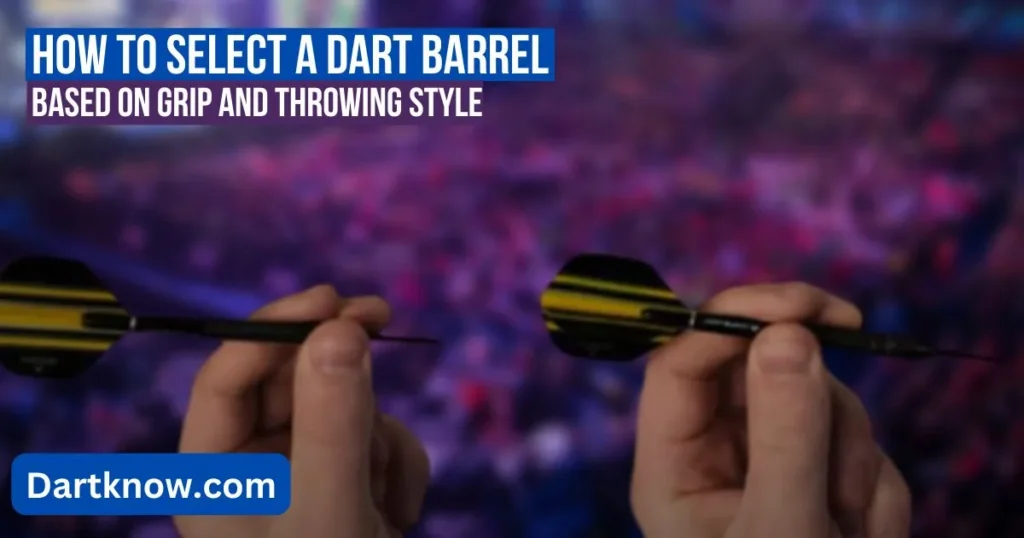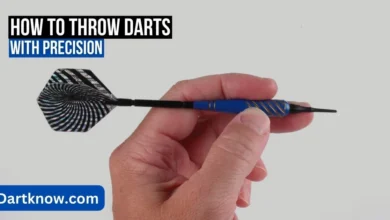What Dart Barrel Should I Use?

Choosing the right dart barrel is essential for improving your game and accuracy. Dart barrels are key in how darts feel and perform during gameplay. Your preferences for the barrel’s grip, weight, and shape can significantly affect your performance. Beginners might need lighter and more forgiving barrels, while advanced players often prefer heavier or more specialized options.
The type of game you play, whether steel tip or soft tip darts, also impacts the ideal barrel choice. Understanding the different kinds of dart barrels can help you find one that fits your style. Recommendations often include tungsten barrels for durability and precision or brass barrels for casual players.
Testing various options and understanding your grip style are crucial steps in making the best decision. With the right dart barrel, you’ll enjoy better control, improved consistency, and a more comfortable grip.
Understanding Dart Barrel Types
Understanding the types available is essential when choosing dart barrels. Different shapes, styles, and designs suit various playing preferences. Each type influences how the dart feels, throws, and performs during gameplay. Let’s break it down step by step.
Barrel Shapes and Styles
Barrel shapes play a significant role in how your darts perform. Common shapes include slim, standard, bullet, torpedo, and cylindrical barrels. Each shape is designed with a specific playing style in mind.
For example, bullet and torpedo-shaped barrels are short and often great for close, precise throws. Cylindrical barrels are more extended and usually preferred for grip stability and accuracy. Choosing the right barrel shape depends on your grip style and throwing technique.
Slim vs. Standard Dart Barrels Comparison
Slim barrels are narrow and lightweight, making them ideal for tight groupings. They offer more space on the dartboard, which is helpful in competitive play.
On the other hand, standard barrels are thicker and heavier, providing a firmer grip for players who want more control. Both options have unique benefits, so testing them can help you decide which feels better.
Barrel Weight Selection
The weight of your dart barrel significantly affects your accuracy and throw. Lighter barrels require a softer throwing style and offer better control for beginners. Heavier barrels provide stability and are often preferred by experienced players with a consistent throw.
What Weight Should You Choose?
Beginners can start with barrels weighing 18-20 grams, which are easier to handle. Professional players often opt for heavier barrels, in the range of 22-24 grams, for better precision. Testing different weights helps you find the one that matches your grip and throwing style.
Guide to Dart Barrel Materials
Choosing the right dart barrel material is crucial for improving your game. Each material offers unique advantages, making some better suited for beginners and others for pros. Here’s a detailed guide to help you understand the options.
Tungsten Dart Barrels Benefits
Tungsten dart barrels are a favorite among professional players for many reasons. The high density of tungsten allows barrels to be thinner while maintaining weight, making it easier to group darts closely. This feature improves your accuracy during competitive play.
Tungsten is also highly durable, meaning your darts will last longer even with frequent use. Additionally, the material provides excellent grip, enhancing control for consistent throwing. These qualities make tungsten a top choice for serious players aiming for precision.
Other Materials: Brass, Nickel, and Aluminum
Materials like brass, nickel, or aluminum may be better for casual players or beginners. Brass barrels are affordable and lightweight, making them great for beginners learning the game. However, they wear out faster over time.
Nickel barrels are more durable than brass, offering decent performance at an affordable price. Aluminum barrels are lightweight and rust-resistant but don’t provide as firm a grip as tungsten. Each material has pros and cons, making it essential to choose based on your goals and experience level.
How to Select a Dart Barrel Based on Grip and Throwing Style

Finding the right dart barrel depends on your grip style and throwing preferences.
Identifying Different Dart Grip Styles
Several common dart grip styles exist, including the three-finger, pencil, and power grips. The three-finger grip is ideal for players who want better control over their dart’s trajectory. The pencil grip often suits players with a more delicate and smooth throwing motion.
The power grip involves more fingers wrapped around the barrel, offering stability for forceful throws. Identifying your natural grip style is the first step to selecting the best barrel.
Matching Barrel Design to Grip Style
Once you know your grip style, look for a barrel that complements it. Players using the 3-finger grip may benefit from thinner barrels for better finger placement and precision. Pencil grip users should consider tapered barrels, which are easy to handle for lighter throws.
Power grip players often prefer thicker barrels that provide a firm and stable hold. Selecting the right barrel design improves accuracy and control for all skill levels.
By focusing on proper materials and grip styles, you’ll be able to find the ideal dart barrel to elevate your game.
Steel Tip vs. Soft Tip Dart Barrels
Knowing the differences between steel-tip and soft-tip dart barrels. Steel tip barrels are heavier, made from durable materials like tungsten, and are commonly used in professional settings or traditional dartboards. Soft-tip barrels, on the other hand, are lighter and designed for electronic dartboards, making them safer for casual play.
Steel tip barrels offer better precision and control if you’re a professional or serious player. However, soft-tip barrels are ideal for beginners or family game nights due to their forgiving nature and lightweight design. Understanding the differences ensures you pick the right barrel for your playing style and skill level.
Dart Barrel Recommendations by Skill Level
Best Dart Barrels for Beginners
For beginners, lightweight dart barrels with an easy-to-hold design are the best choice. Brass barrels are a budget-friendly option that allows new players to get comfortable. Look for barrels with a wider grip area to ensure better control during throws.
This makes learning and improving accuracy more manageable. Many beginners prefer soft-tip darts on electronic boards for safety and ease of use.
Intermediate and Professional Dart Barrels
More experienced players usually benefit from heavier tungsten barrels. Tungsten barrels are dense and provide excellent stability and precision, which is crucial for competitive games. Professionals also favor thinner, strategically designed barrels to refine their grip and improve consistent play.
Steel tip darts with tungsten barrels are often the go-to for higher competition levels or traditional pub-style games. Choosing the right barrel at this stage can significantly elevate performance.
Selecting a dart barrel suited for your skill level and game type will make improving your technique and enjoying the game easier.
Conclusion
When choosing the best dart barrel, remember these key factors: shape, weight, material, and grip. Each plays a crucial role in how your dart performs during a game. Experiment with different barrel types to discover what feels right in your hand.
The barrel’s shape can affect your grip, while its weight influences your throw’s accuracy. Materials like tungsten ensure durability and stability for competitive players. For beginners, lighter and softer materials are often easier to handle safely.
Always pick a barrel that fits your skill level and preferred game style. Finding the perfect barrel might take time, but it’s worth the effort. Explore various options and practice regularly to refine your technique. Start experimenting today, and take your dart game to the next level!
FAQs
What length is the barrel for darts?
The best barrel length depends on your grip style and personal comfort level. Shorter barrels work better for precise finger control, while longer barrels offer stability. Test different barrel lengths to find the perfect match for your throwing technique.
What kind of barrels do darts use?
Darts use straight torpedo barrels and specialized shapes for different play styles. Straight barrels are versatile and suit most grips, while torpedo shapes offer better balance. Choose a barrel type based on comfort and your gameplay goals.
What weight dart barrel should I use?
The ideal weight varies, but beginners often find 20-gram barrels easiest to control. Heavier barrels offer stability for experienced players who can handle more consistent throws. Always pick a weight that suits your practice level and throwing strength.
Which barrel material is best for casual players?
For casual players, brass or nickel-silver barrels are budget-friendly and easy to use. These materials are lightweight and durable, perfect for beginners improving their skills. Tungsten barrels last longer but are unnecessary for recreational players just starting out.
How does barrel shape affect accuracy?
Barrel shapes like tapered or straight styles help improve control and grip consistency. A comfortable grip prevents slips, improving accuracy and confidence in your throws. Pick a shape that complements how you hold the dart naturally.




